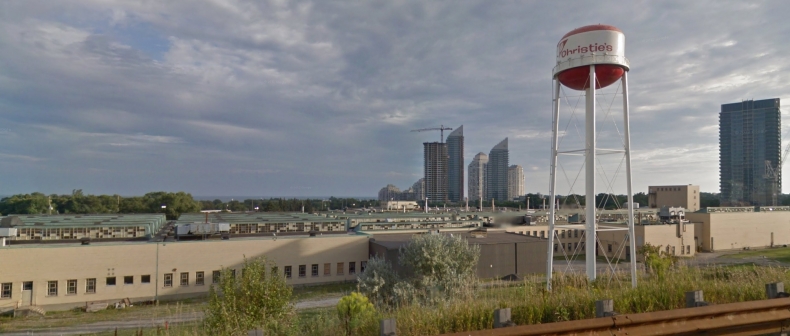
Mr. Christie Bakery in South Etobicoke. Image via Google Maps
Toronto has a lot of food processing plants. They are scattered everywhere, sometimes unassuming. Some are slotted between railroad tracks and mixed-use neighbourhoods, others are situated on the outskirts of the city behind highways. Most of the buildings are aged and dilapidated and there is barely any signage that tells us what goes on in these big grey factories. And even though some of them have been around for 40 or 50 years, for many of us these complexes barely evoke a passing thought. “It’s where stuff happens.”
That is unless of course there is a factory on your street where you live.
If your live near one of these food processing plants you may live in a constant dream-state where every time you walk out to collect your mail you get high on the air after catching a wafting breeze that smells like croissants or fresh bread or chocolate, or you may live in a rage and shake your fist at the convoy of dusty old trucks rumbling into the factory compound hitting every pothole imaginable and rattling like hundreds of empty tins banging together and clogging traffic. It’s a complicated relationship.
Whether we love them or hate them, many of these factories were around before some city neighbourhoods even existed and have served as engines of community growth. They’re home to thousands of jobs and over time the food processing industry has built itself up to become an indispensable economic beast. Plants like bakeries have co-existed with residential neighbourhoods and by and large, the city has helped manage these relationships. But of late, the city is grappling with how to keep these structures intact. Land is becoming scarce and developers are swooping in when factories close to transform the land into more profitable residential uses. Increasingly, operating a factory can be a money losing operation.
In early November, Etobicoke’s Christie Cookie Plant announced it will shut the door on the factory after more than 60 years of operation, culling 550 jobs in the process. The owners indicated the cost of keeping the plant in a state of good repair coupled with spiking shipping costs forced them to make a regrettable business decision. As land values rise and maintenance costs increase, owners may become more willing to close factories and sell the land off to developers who circle in like vultures once they get a whiff that land is up for grabs. Nestlé Canada is knee-deep in this exact scenario. They are opposing the development of a mixed-use complex on the vacant plot next to their Sterling Road factory citing concerns about potential costs that would be imposed on them once the land is re-zoned and complaints that would be levied against them when new residents move in.
The food processing industry is clearly an integral part of Toronto’s economy. It’s a $20 billion industry that employs around 60,000 food workers in the city and surrounding area. A study of food industry growth trends in Toronto conducted on behalf of Ontario Ministry of Agriculture and Food and the City of Toronto Economic Development identified Toronto as the second largest food cluster in North America, behind Los Angeles. Food industry is everything from retailers to warehousing and distribution. It includes manufacturing and food processing plants and peripheral industries like packaging and equipment. The study pointed out there are more than 400 food processing operations spread across the city. According to a Globe and Mail report, the food processing industry, dominated by big players like Maple Leafs Foods, Kraft Canada and Fierra Foods, is the fastest growing sector in the region because of an increasingly diverse population that demands a wide variety of products.
With changing trends in food demand, the shrinking availability of land for industrial use and an increase in competition between multinational corporations, challenges will continue to pester the food industry. So the question must be asked: how do we balance the demand to build places where people can live with the need to make food for people to eat?
Nestlé factory on Sterling Road (seen from Dundas St. W). Image via Google Maps
Councillor Peter Milczyn for Etobicoke Lakeshore, Ward 5, where the Christie plant is located says that because of the age of some of the food processing facilities, they have become entrenched and surrounded by mixed-use neighbourhoods and find it incredibly difficult to find space to expand and spread out.
“These pressures sometimes force business decisions that see Toronto lose our businesses. That is why it is important to protect employment lands so that a supply of available sites for business to locate to is preserved,” he said. “The city’s ability to make these decisions final and binding without leave to appeal to the Ontario Municipal Board is crucial to this approach.”
Once every five years as part of the Municipal Comprehensive Review, all property owners get an opportunity to potentially appeal council’s refusal to convert employment lands. Cllr Milczyn says the city must ensure there are sufficient, affordable employment sites throughout the city to allow business to expand, new businesses to form, and to attract new investment into the city.
“City staff will be proposing stronger and clearer policies for our official plan to protect employment lands,” he said. “One of our challenges is to encourage more true mixed-use development where employment spaces are built in to residential developments. We want mixed use areas to offer places of employment but not for industrial areas to create opportunities for residential developers.”
But as condos continue to encroach on employment lands, complaints from the surrounding community are being heaped onto the pile of pressures facing factory owners. Michael Williams, General Manager of Economic Development and Culture at the City of Toronto says the two major complaints he comes across from residents that live near a processing plant are the noise from truck movements and the smell.
“Typically, the plants have been there longer than residents for the most part and residents who have evolved with the neighbourhood have learned to adjust to industry over time,” he said “It’s the new residents that move in that seem to have less patience than their pre-dated neighbours.”
According to Williams, despite the influx of new residents, the city is working to keep existing plants in their current location and hopes to attract new business so the industry can keep growing. The Redpath Sugar refinery is one plant under the urban microscope. Here sits a factory on 4.25 hectares of prime real estate, cornered in by condo developments in the centre of a major waterfront renewal project. The 52-year-old sugar shed is land the city is trying to keep intact amid growing pressures from developers.
“Toronto seems to be able to — not easily — manage that relationship. If they try and sell it as residential, the money they’d receive wouldn’t be enough to re-build elsewhere. It’s a vital piece of the food manufacturing industry,” he said. “How will it coexist moving forward? It’s all situational. Toronto has a hot economy right now so we can see these issues existing for a long time to come. There is no one answer that fits all.”
To be continued… Next week, Part II explores solutions and successful examples of how factories are located peacefully near residential areas, here and around the world.
____
Justin Robertson is a freelance journalist from Toronto. His work has appeared in The Walrus, National Post and Toronto Standard. Follow Justin on Twitter @justinjourno
For more, follow us on Twitter @TorontoStandard and subscribe to our newsletter.














